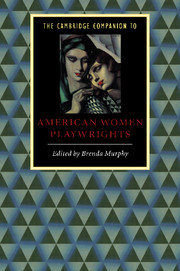Book contents
9 - From Harlem to Broadway
African American women playwrights at mid-century
from Part 2 - Inheritors
Published online by Cambridge University Press: 28 May 2006
Summary
World War II ended in 1945, ushering in a mid-century decade of major change in the world and especially in the United States. The flowering of African American literature, known as the Harlem Renaissance, had seemed to fade as writers tried to cope with the Great Depression and a World War forcing them to a new understanding of their place in the world. While the US labor force adjusted itself in order to accommodate returning soldiers, African American soldiers returned to ambivalence at home. Women were displaced from the wartime jobs that they had taken on the domestic front, but white, not black, veterans replaced them. Segregation and discrimination still prevailed in jobs, housing, and schools. But the 1950s would herald a measure of “progress,” however conflicted. In 1954, the Supreme Court declared separate schools inherently unequal, and the Interstate Commerce Commission banned segregation in interstate travel. Later, in 1957, Congress passed the first Civil Rights Act since 1875. The world and the country settled uneasily into the new phenomenon of a Cold War in an atomic age, while Senator Joe McCarthy continued his hunt for communists and homosexuals at home. The lifestyle of American families was changing rapidly as whites fled the cities and settled into new suburban housing developments, made affordable by the GI Bill and the adaptation of the assembly line to housing construction, while blacks were kept out to a large degree. As women returned to their kitchens, the pressure increased for them to conform to traditional family expectations - those of wife and mother.
- Type
- Chapter
- Information
- The Cambridge Companion to American Women Playwrights , pp. 134 - 152Publisher: Cambridge University PressPrint publication year: 1999

